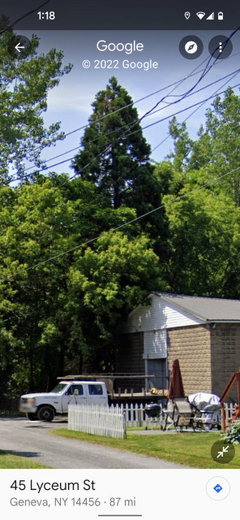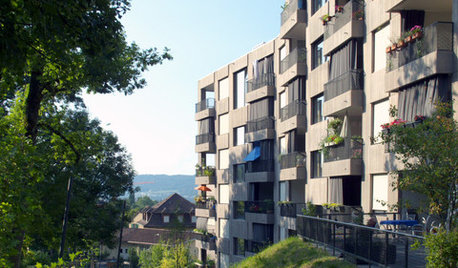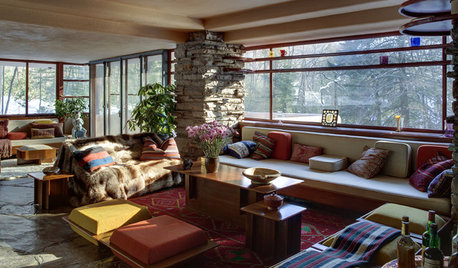Geneva, NY Sequoiadendron
Hi all,
I visited the giant sequoia tree in Geneva, NY about four years ago after receiving directions from someone here on gardenweb. However, I misplaced the directions since my last visit! I'd like to visit the tree again and see how it is doing. Could someone please offer driving directions to the house where the Geneva tree is growing? I promise I won't lose the directions this time! Thanks!
Comments (41)
treeguy_ny USDA z6a WNY
Original Author14 years agoClose but no cigar, Resin. Thanks though : )
Seriously now, nobody knows how to get to this tree?
Related Professionals
Bridgetown Landscape Architects & Landscape Designers · Birmingham Landscape Architects & Landscape Designers · Erie Landscape Architects & Landscape Designers · Glassmanor Landscape Architects & Landscape Designers · Lowell Landscape Architects & Landscape Designers · Goodyear Landscape Contractors · Middletown Landscape Contractors · Bound Brook Landscape Contractors · Downey Landscape Contractors · Fort Atkinson Landscape Contractors · Golden Landscape Contractors · Hilton Head Island Landscape Contractors · La Verne Landscape Contractors · Mastic Beach Landscape Contractors · Plainview Landscape ContractorsSmivies (Ontario - 5b)
14 years agoThe photo request is still valid!
RE: New York Giant Sequoia
Posted by: greyneedle z6b NJ (My Page) on Sun, Aug 15, 04 at 23:1443 Lyceum St., next to a large storage shed. Park on the street and walk down the service road. Information available online. Have fun! Can you post a picture?
I was just visiting the Burlington Sequoia today. In typical Sequoia fashion, the two trees look nothing alike (particularly the bark--Geneva is red and smooth).treeguy_ny USDA z6a WNY
Original Author14 years agoDid I not post pictures last time I visited it? If so, sorry! I will take more pictures this visit. I have some from last time, but they're not the best quality, new ones will be better.
Here are some pictures of a giant sequoia in Ithaca, NY. I talked to a seuqoia grower out west about the top die-back on this tree. He said: "I think that dead top thing is due to a deficiency. I see it a lot in trees from the eastern US. The giant sequoias are heavy feeders. They grow in very rich moist soil in their natural habitat. I think the tops abort when conditions are not supplying them the moisture and or nutrients that the tree requires. The roots can only sustain as as much foliage as they can feed. If the soil gets too dry or poor the tree has to abort something. Usually it is lower branches but when the tree is in full sun the top may go because it requires more enery to push the sap that high." What does everyone here think?
Tree in Ithaca:
{{gwi:663523}}
{{gwi:663525}}
My camera case, for size reference, is 6.5x5":
{{gwi:663527}}
{{gwi:663529}}
And, the tree is coning! Chances of viable seed are slim to none without a second tree for pollination:
{{gwi:663531}}pineresin
14 years ago"Close but no cigar, Resin"
That's good, because I can't stand the vile stink of the things . . . utterly disgusting ;-)
"about the top die-back on this tree"
Lightning strike. Very common in Giant Sequoias, as they so typically stand with their pointed tops high above everything else. The nutrient deficiency theory can be discounted, as the rest of the foliage is in very good condition.
Where you get multiple trees together, it doesn't happen to other than odd ones here-and-there.
{{gwi:330110}}
{{gwi:360011}}Resin
treeguy_ny USDA z6a WNY
Original Author14 years agoHey Joe,
Thanks for posting a link to the pictures I sent you. I'll send you the new ones of the Geneva tree once I've visited it.
Resin,
Lovely pics of giant sequoias from across the pond, I'm jealous! I thought Joe's theory on lack of water/nutrients was more likely to be correct in this case. In looking at the top of the tree, I cannot see any signs of lightning strike. Every other tree I've seen with lightning strike shows at least some outward sign of the event: split bark, small chunks/pieces "blown" off, small charred sections, etc. Is it possible for a tree to get struck by lightning and not show physical signs beside die-back? Interesting.pineresin
14 years agoHi Treeguy,
Thanks! Yep, they're a delight to wander among; one in the top pic is 48m tall and most of the rest 42-46m, big enough to give a real sense of awe.
Lightning strike is well-recorded here as the cause of dead tops in Giant Sequoia (e.g. Phillips & Burdekin (1992), Diseases of Forest and Ornamental Trees, chapter on abiotic damage). Not sure of the mechanism of why there's no signs lower down the tree, but perhaps the very thick bark helps protect it from damage, with only the thin-barked upper crown damaged. The thick bark holds plenty of rain water, which should give the electricity an easier outside route to the soil. Equally, I've seen a Giant Sequoia that was totally exploded by lightning, and know of another very similar case (in Geneva!).
Resin
treeguy_ny USDA z6a WNY
Original Author14 years agoHey Resin, Thanks for the info on lightning strike. Interesting theory about the rain-covered bark providing an alternate route to the soil, makes sense.
sluice
14 years agoIf you look on Google street view, is it the tree behind the white house, looking down the service road on the right?
Incidentally, there's a nice weeper at 34 Lyceum St., the house with the blue car parked in the front yard.
And Resin, the pic of the tree lined street is fantastic!
riconiferman
14 years agoIf you're ever in Rhode Island, the largest tree at Blithewold is worth seeing one's worth seeing. I understand it's one of the largest on the East coast.
treeguy_ny USDA z6a WNY
Original Author14 years agoThat's pretty interesting RIconiferman. Do you know the height/crown spread/trunk diameter of this specimen? I'm curious since it claims to be the "tallest of its kind" east of the Rockies!
wadet
14 years agoHi treeguy ny. I'm not Joe Welker, but in 2006 I contributed a two GS photos in the Washington state gallery.:))
As of 2005, this might be the biggest Sequoiadendron giganteum east of the Rockies (pasted from another site):
Well I almost had a new champ, although the current champ was last measured with just a clinometer. The tree I visited today was planted by the same person, Minshall Painter, back in the 1840's.
The current champ Sequoiadendron giganteum weighs in as follows:
159" CBH 99' tall with a 33' avg spread for 266 points
The challenger came in at:
148" CBH 86.2' tall with a 31' avg spread for 242 points
Here are two pics of the second largest sequoia in Pa
12.3x86.2 located in Delaware county Pa 242 point tree
{{gwi:663534}}
{{gwi:663536}}pineresin
14 years ago"I'm curious since it claims to be the "tallest of its kind" east of the Rockies!"
Hmmm . . . does Britain count as "east of the Rockies"?!? ;-)
Tallest: two at 54m, Benmore and Blair Atholl
Stoutest: 357cm d.b.h., Wiltshire, and 355cm d.b.h., near PerthAs far as I'm aware, these are the largest in cultivation anywhere, unless maybe New Zealand has any larger. Only the wild ones in Calif are bigger.
Resin
Smivies (Ontario - 5b)
14 years agoYou can't see the tree from Street view. It's obscured by the deciduous trees behind the white house. You can see it from Google Earth, at the SE corner of the building behind the houses. It's casting a shadow over the roof of that building.
gardener365
14 years agoEvan-treeguy,
That's a great GS in Ithica. I know Resin is far more intelligent than I, but I do think that the die-back on Sequoia's on the East Coast is due to not enough water. All too many examples show valid indication to me. Surely some are hit by lighting, I can't disclaim that...
Nice one too wadet in PA. Is that Fraser fir at your place, still your favorite?
Have a nice day guys,
Dax
treeguy_ny USDA z6a WNY
Original Author14 years agoSorry Wadet, I erroneously assumed that you were Joe because of the link to his gallery! Impressive numbers for thos sequoias. I know it's comletely inaccurate, but I'll eye-ball the height of the Geneva tree while I'm there using a stationary object next to it.
Yes, Resin, the trees in Britain are tehcnically east of the Rockies . . . wish they grew as well here in the eastern US.
pinetree30
14 years agoThe dieback is not due to lack of water. The dead section apparently died all at once, as there is no sign it is progressive: the foliage below the dead stick is normal. And lightning is unlikely. Lightning has great power and rips into young bark or old bark, and rides down in the moist cambium or sapwood. Trees just struck are still boiling along the lightning path. This is a classic example of trying to diagnose something you cannot see closely enough to make an intelligent guess. So I'll make an(other) unintelligent guess and blame a porcupine that girdled the base of the dead section. Because somehow, it did get girdled. And don't tell me porkies don't like cupressoids.
botann
14 years agoI'm in favor of lack of water. There are several Giant Sequoias in my area that have dead tops. No apparent lightning damage. All have been turned into parking lots adjacent to the trunks with a layer of asphalt all around them. They were doing fine until several years after the asphalt was laid. Cause and effect seems connected.
riconiferman
14 years agoAs for the one at Blithewold, I doubt it's much more than 90'. It doesn't appear to have grown much in the past decade. The claim to be tallest east of the Rockies was made in the mid 1990's, and it's not much taller now. It is quite large though. There is a 30' yew just to the right of it in that picture. I'd guess the diameter at 4' high is well more than 4'. Maybe more than 5'. I'll have to make the trip over to see it sometime.
Here are a few more pictures
[img]http://ic2.pbase.com/g1/71/685571/2/97622778.5i0do8jb.jpg[/img]
[img]http://ic2.pbase.com/g1/71/685571/2/97622769.qjAgMt3y.jpg[/img]pineresin
14 years agoHere's your pics, formatted correctly ;-)
{{gwi:663537}}
{{gwi:663539}}
Looks healthy, tho' a mite short and stubby-topped. It would be interesting to try some in that area in forest conditions growing with other tall trees.
Resin
riconiferman
14 years agoYes, quite healthy. I doubt at this point it grows more than a couple of inches a year in height. Those pics are from 2008. It's only about 500 meters from the edge of a bay, so it gets plenty of water. There are others in the area, most are the offspring of this tree, that are growing closer together, but probably none are more than 40-50 years old. Not long enough to tell what the branch structure or height will turn out like.
Sequoias in that area are MUCH healthier looking than any at other local gardens or arboretums. Arnold Arboretum in Boston has several, but all look stunted, have lost their tops or get burned in the winter/summer. I think being close to the coast moderates the climate enough to keep them healthier than sites further inland or further north.
wadet
14 years agoIt's unlikely the Ithaca, NY tree's dead top is from lack of water. That part N/A receives it's maximum precipitation and humidity during summer. In the PACNW, the reverse is true with maximum precipitation during winter. Summers are very San Diego-like (dry and mild). Haven't seen any GS's with dead tops locally.
IMHO, the likely scenario would be extreme winter burn followed by summer fungus activity and/or soil compaction.
Here's an example in GS soil compaction:
4/2008:
{{gwi:600354}}
{{gwi:600356}}
4/2010 with noticeable improvement:
{{gwi:663542}}
{{gwi:663543}}
The mentioned northern trees are not fenced.pineresin
14 years agoHope the treatment works.
Resin
PS for Wadet: can you resize your photobucket pics to max. 1000 pixels width, please?
The ultra-wide pics make the text on all the rest of the thread nearly impossible to read. Thanks!treeguy_ny USDA z6a WNY
Original Author14 years agoI have some pictures from my visit to the Geneva tree a couple weeks ago. When I get some time, I'll post them. Sadly, the tree is declining in health; it's days look numbered. Because of whatever stress(es) is/are killing the tree, it's coning like crazy. I picked up a couple dozen ripe cones that were lying under the tree.
wadet
14 years agoNot sure what happened with my photobucket upload settings Resin. The images have been changed.
davidrt28 (zone 7)
14 years agoI think wadet has the best answer.
One of the limiting factors to the height of any tree, anywhere in the world, is the physics of moving enough water high enough to sustain the top of the plant. It makes sense that the very top would be the most susceptible to winter burn.reificationofmyth
last yearSorry for resurrecting such a long-dead thread, but as someone who has spent too many hours searching for a sequioadendron in Ontario with little success excluding Niagara, I can't help myself from asking: Smivies, is the tree you referred to twelve years ago in Burlington, New York, or Burlington, Ontario,…or even Burlington, Vermont? Also (although slightly ambitious), have you seen any sequioadendron in Toronto?
treeguy_ny USDA z6a WNY
Original Authorlast yearWhile I can't comment on which Burlington has a Sequoiadendron, I just looked at the street view of the Geneva, NY tree. I haven't been to visit it since my earlier comments in this thread. Apparently, it is still alive and well as the screenshot I am linking is from just now and says copyright 2022 by google. The tree appears healthy:

reificationofmyth
last yeartreeguy_ny, I was just looking at Google Street View on Safari and saw that your screenshot is from 2019. Definitely recent enough to be hopeful! It looks better than the ones at Niagara Botanical Gardens (which get similar temps), though I can't see the bottom branches well, which is where most of the Niagara sequoias have dieback. Perhaps this has to do with the sheltered location of the Geneva tree? Oh, any update on the Ithaca Sequoiadendron?
BTW, what do you guys think is the coldest zone a giant sequoia could endure? I don't believe that all zone 5 or 6 locations are the same. Is it extreme lows that limit giant sequoias or average lows? In other words, is it better to go to -15F often and never to -25F, or to go to -25F once in a decade but have average lows near -5F? Considering the survival of giant sequoias in both Moscow, Idaho, and Fort Collins, Colorado, I suspect the latter but am unsure. From what I've seen, North East cold is different; it's more consistent than the west, having much lower average winter highs but less low extremes. Geneva seems to be around -10F at the lowest (6a), but my area east of Toronto is around 5 degrees colder, with lows closer to -15F (or 5b). From the other threads I've seen online, I suspect I would need a cultivar (glaucum, Hazel Smith, or Idaho Endurance)...and some good luck, too. But regarding the task of obtaining a cultivar in Canada: GOOD LUCK.
bengz6westmd
last yearlast modified: last yearSaw a giant sequoia on the grounds of The University of Utah in Salt Lake City. Very big w/healthy low branches, so it can take that climate. Pretty much had to have been watered at least when young.
Smivies (Ontario - 5b)
last yearThe reference to a Burlington Sequoia was actually a quoted post, not mine. I don't know which Burlington was being referenced but it wasn't Ontario.
I only know of one in Ontario at a friends place near Turkey Point on Lake Erie. It's got Cercospora Twig Blight and doesn't look great....I'd expect that scenario applies to anyone trying to grow them.reificationofmyth
last yearDang, Smivies, I had my overexcited blinders on! Somehow I totally missed the fact that the post was by greyneedle. After you pointed this out, I can answer my question of which Burlington. I was googling sequoia in Burlington the other day and came across the one at the corner of Mt Holly Rd and Rancocas Rd in Burlington, New Jersey. This is almost certainly the giant sequoia mentioned by greyneedle, as it is an impressive specimen on public property and his zone is listed as 6b NJ.
Anyhow, I read that you believe giant sequoia could be good down to zone 5a if it weren’t for Cercospora blight? Is this cold-tolerreance suspected from the fact that some trees have withstood temps lower than -20F for very short periods of time? Don’t you think that going to temps below its -10F “limit” more often (as it does in an eastern NA zone 5) would do harm? And is there anything one can do to combat the blight?
Thanks again.
Smivies (Ontario - 5b)
last year-20F for short duration is realistic...probably with some burning.
I expect long duration of below freezing winter weather (>10 days) that doesn't allow evergreens to re-hydrate will cause burning as well. Frost depth is also a factor in zone 5...trees that benefit from very reliable snow cover during winter do much better than trees that often experience extreme cold events w/o snow cover.treeguy_ny USDA z6a WNY
Original Authorlast yearThat's part of our problem here. We are a zone 6a due to moderation from Lake Erie - our avg winter absolute minimum is -5F with temps below -10 very rare. However, we will have multiple consecutive weeks in January and February where we do not go above freezing. My 2 foot tall Sequoiadendron was fried to a crisp after this winter. This is my third try with a seed grown Seuqoiadendron - I don't think I'll try again unless it's with 'Hazel Smith' or another supposedly more hardy variety.
bengz6westmd
last yearlast modified: last yearThanks for the update & nice to see you back, treeguy. That NY area is far enough north/inland that the humid-summer-loving fungal diseases are prb'ly not as prevalent. It does have alot of lower branch death, but that's prb'ly from shading.
treeguy_ny USDA z6a WNY
Original Authorlast yearYou're welcome! When I remember, I do stop by the forums a few times a year. Too many other interests and time priorities as my kids are getting bigger/older.
I agree the lower branch death is likely due to shading, its lower crown has canopy coverage from other trees 3/4 of the way around. I think its survival and health are likely due to siting in a protected location, the tempered climate of the finger lakes, and possibly less prevalent fungal pathogens. There are three in the Buffalo area where I live that I am aware of. All three are about half the size of this one. We are moderated by the great lakes similar to the finger lakes near Geneva, but still see a lot of branch tip die-back in the trees I see here. I'm about 100miles west of Geneva, NY. I've failed 4 times to grow Sequoiadenron, all in different places on our two properties.BillMN-z-2-3-4
last yearlast modified: last yearWell, I know nothing about growing Giant Sequoias but from what I understand, the near 100 ft. Manistee, Michigan tree is in an area of Limestone bedrock. Actually there are two other S.g. nearby. Also, I think it is ~zone 7 around that area, even though latitude is higher than yours. Probably good air circulation and I believe it to be an elevated, somewhat protected area higher than the lake itself.
I imagine most trees, not growing in a native environment need several years of good weather conditions to become established before a chance of full survival can be realized in an area that might vary from that in certain years.












treeguy_ny USDA z6a WNYOriginal Author